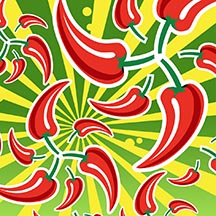Make the most of culinary herbs and spices.
Other articles you might enjoy:
What's a Scoville Heat Unit?
by Sandra Bowens
Here's one that's full of our favorite recipes because we wrote the book! It is also full of information, helpful hints and ideas for using herbs and spices in your kitchen.
A modern compendium of the world's most loved food group.
When Wilbur Scoville developed his test for measuring the heat found in hot peppers back in 1912, do you suppose he ever imagined his name would become an important word in chili-head lingo?
Mr. Scoville's test has become the industry standard for determining just how hot hot really is. Today, you will often find the Scoville Heat Unit rating on a jar of salsa or a bottle of hot sauce. A jalapeno falls in at roughly 4000 heat units while the habanero rates an easy 250,000.
But what does it all mean? Heat units are actually determined by how many parts of sugar water it takes to dilute a sample so that the heat of a chile can no longer be detected. The chile sample is provided in the form of an extract.
The original tests were performed by assembling a large panel of human testers who would taste each sample in increments. Time consuming to say the least.
Even though Scoville's name is still associated with the results, it's all done by machine these days. Laboratories employ High Performance Liquid Chromatography (HPLC) testing. The generally accepted ratings are:
0-5000---Mild
5000-20,000---Medium
20,000-70,000---Hot
70,000-300,000---Extreme
These ratings are handy but bear in mind that many hot sauce producers come up with their own levels and that the chiles themselves can vary from season to season or by the climate where they are cultivated.
For a terrific guide to common chiles.
According to the Guinness Book of World Records, the Red Savina Habanero is the hottest pepper on Earth. It has garnered a rating of 570,000 Scoville Heat Units.
Do you suppose Mr. Scoville ever imagined that?
Read more about the Red Savina pepper.




